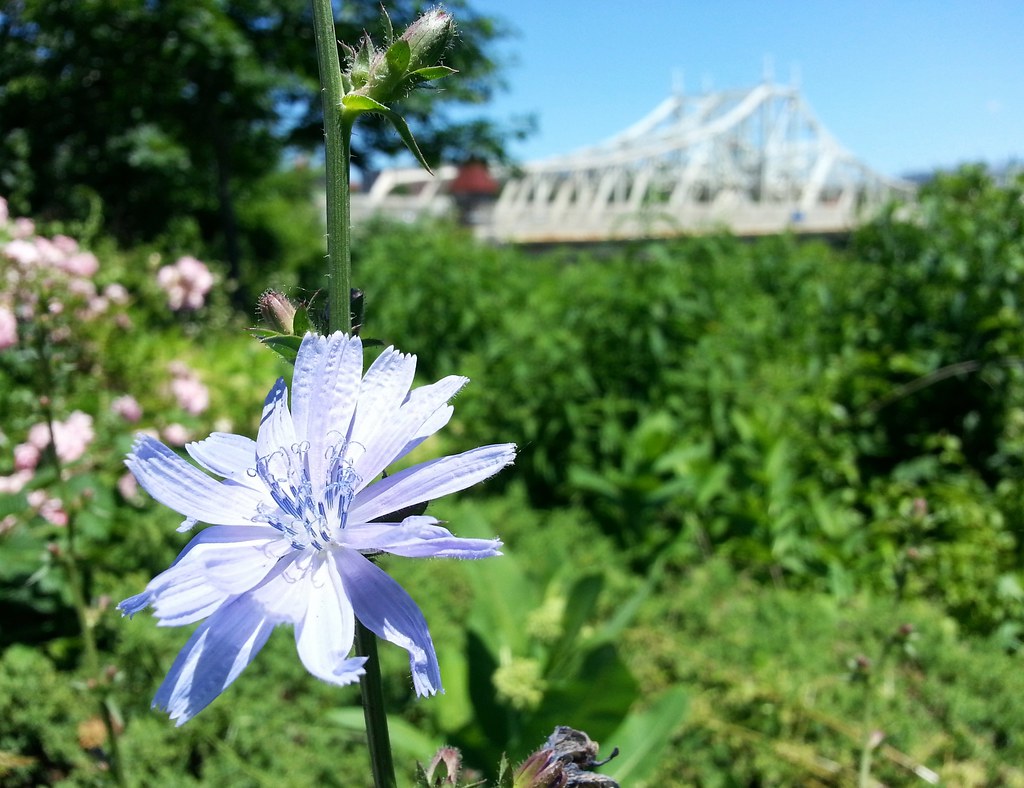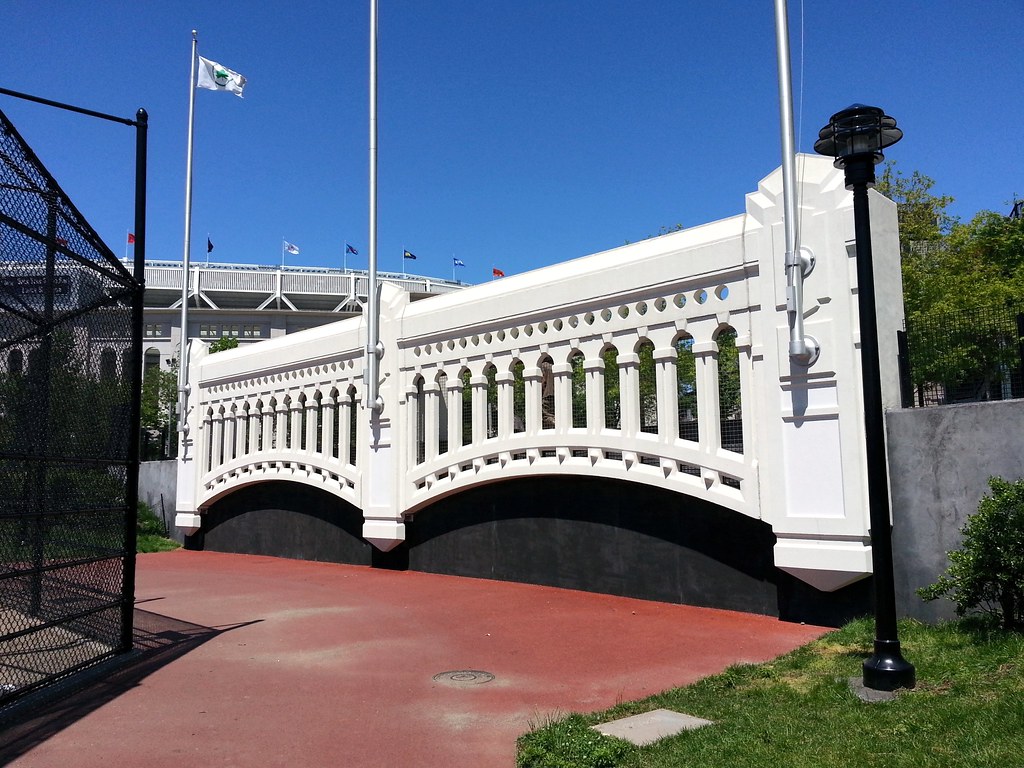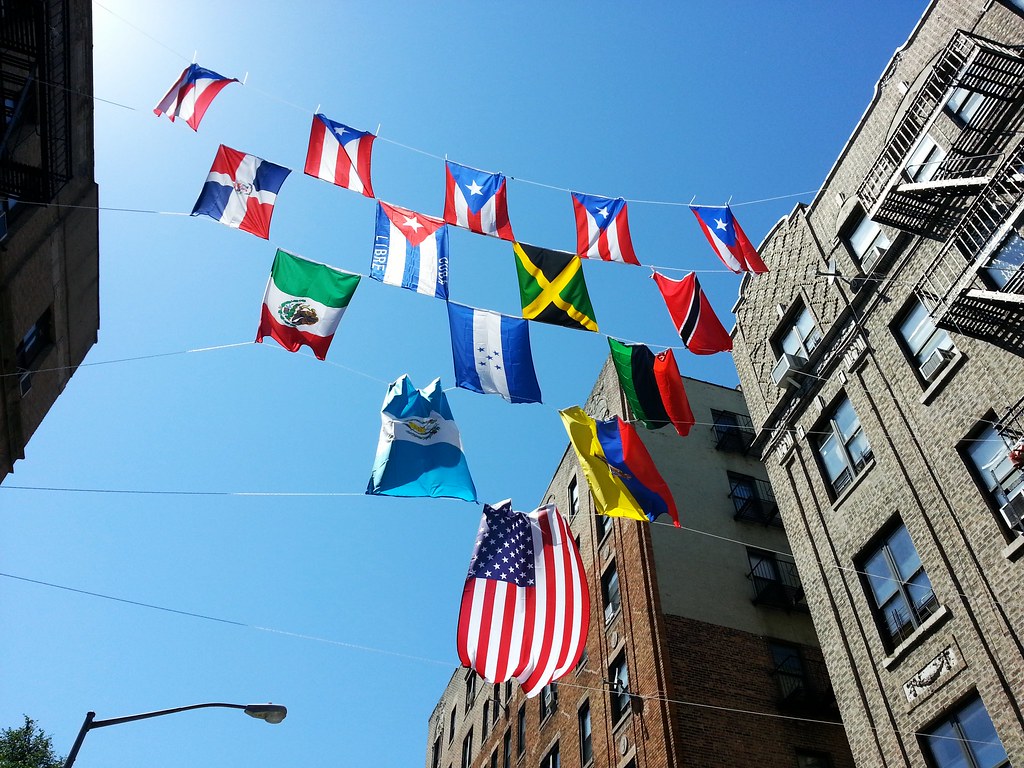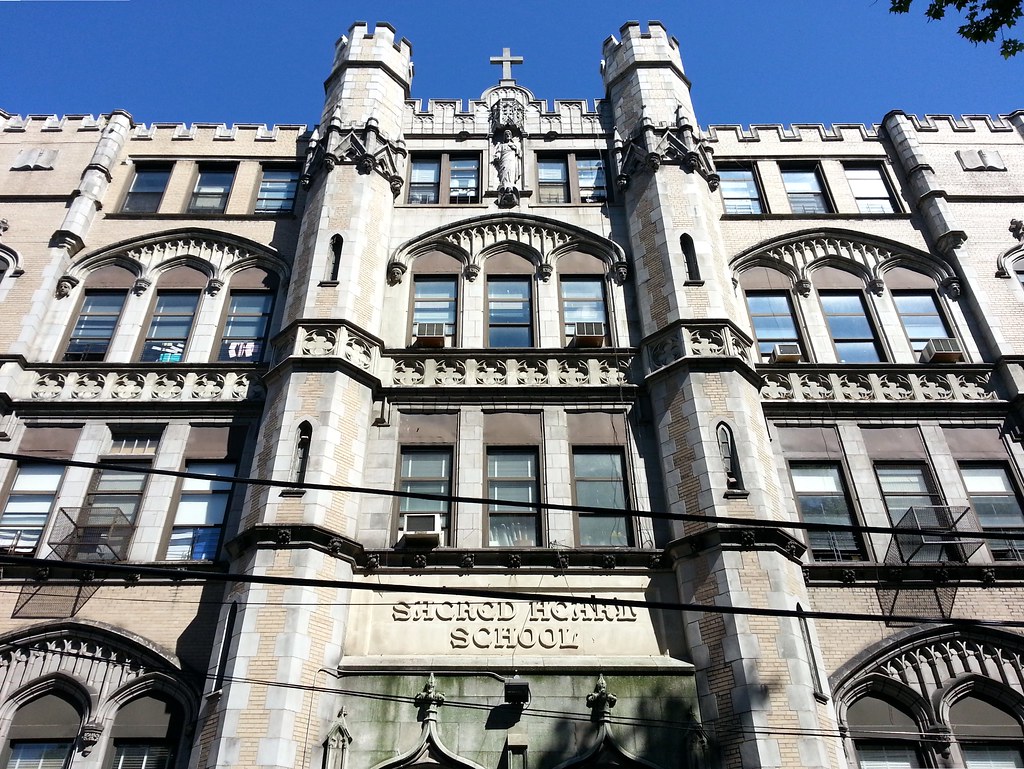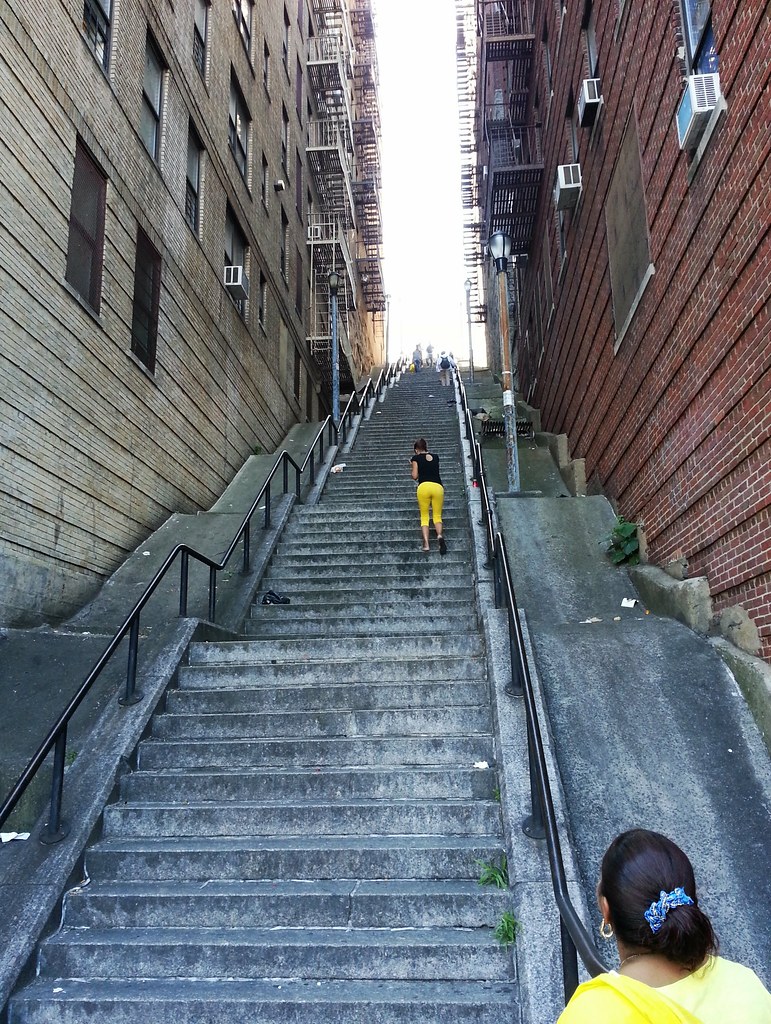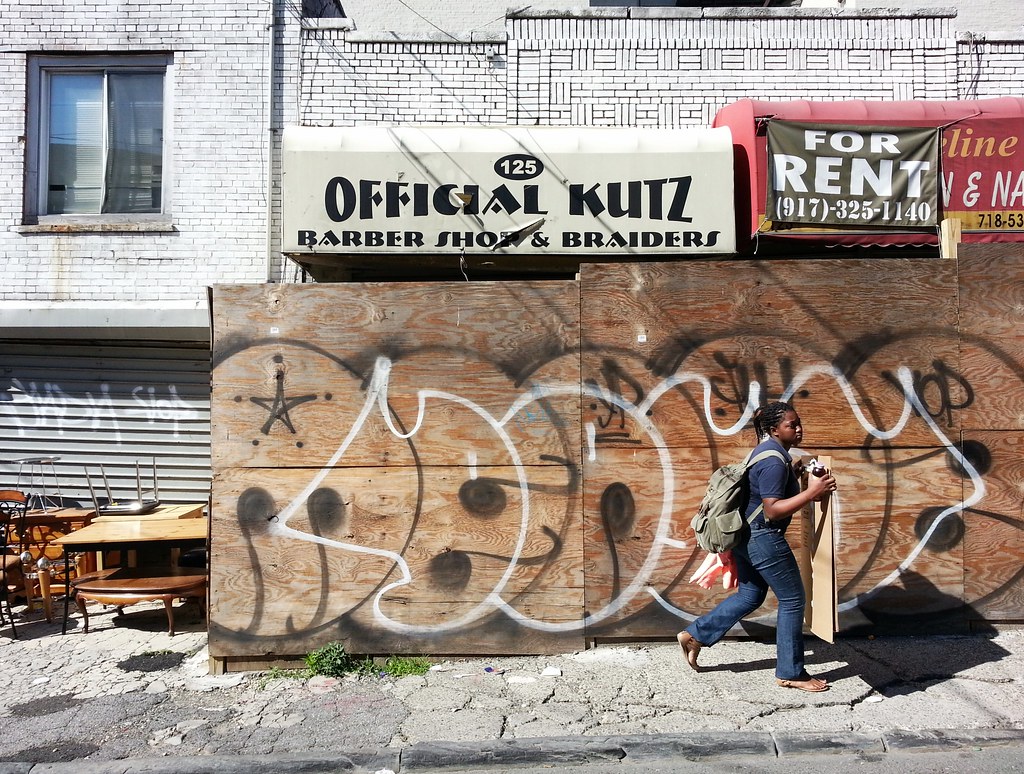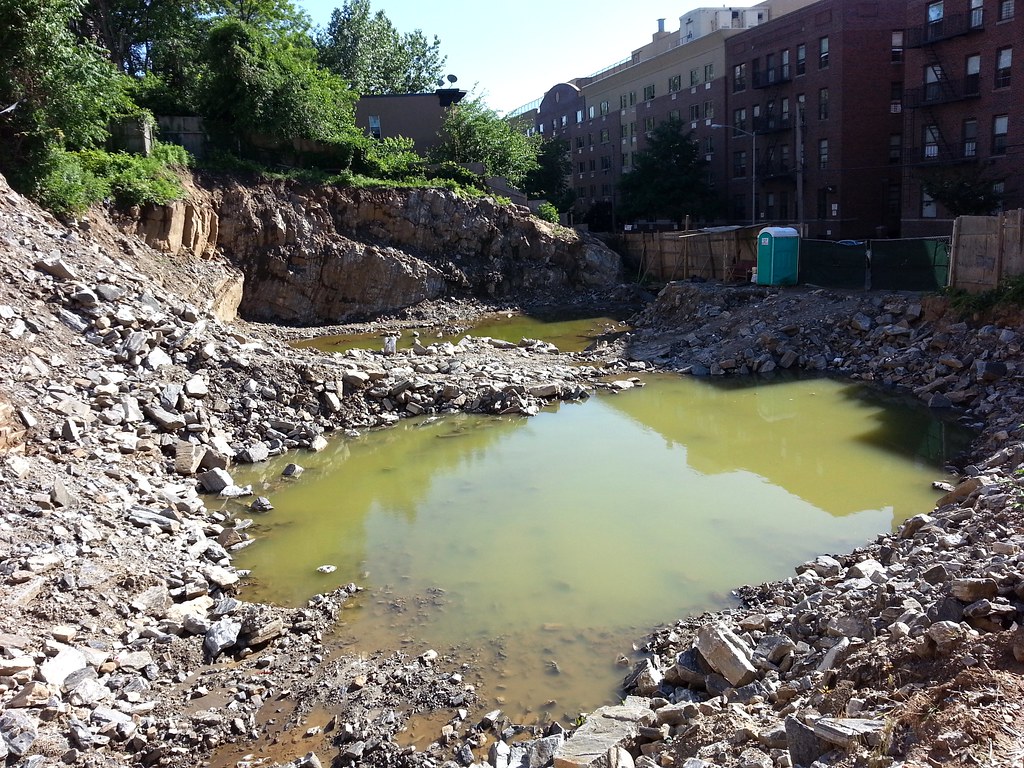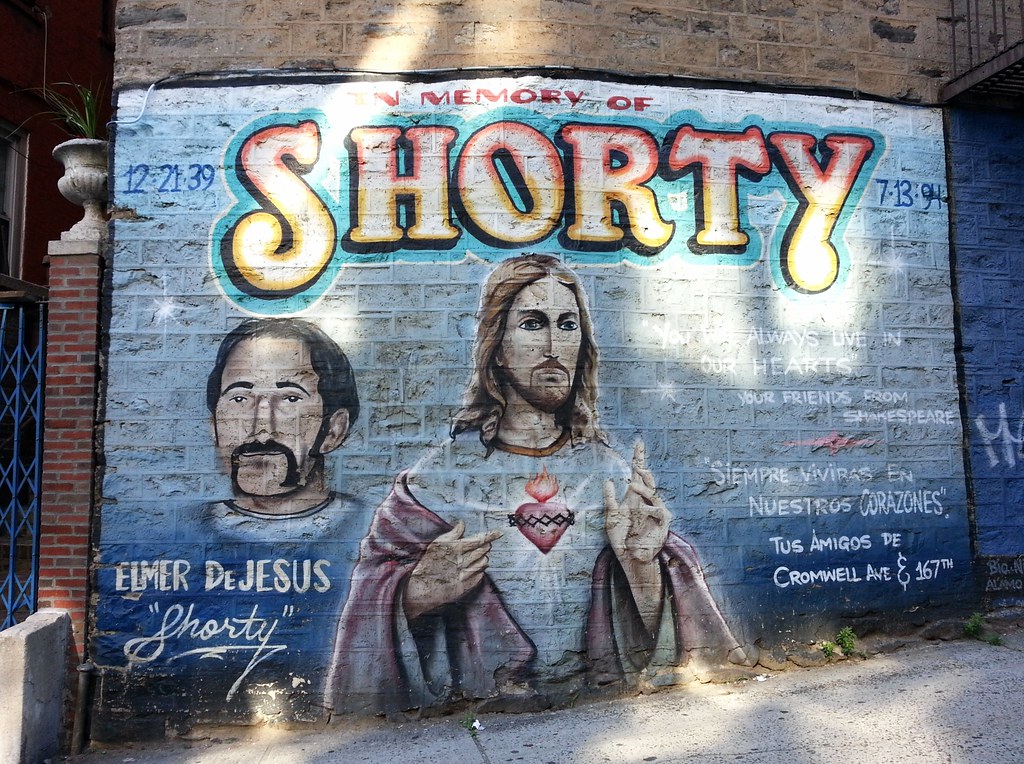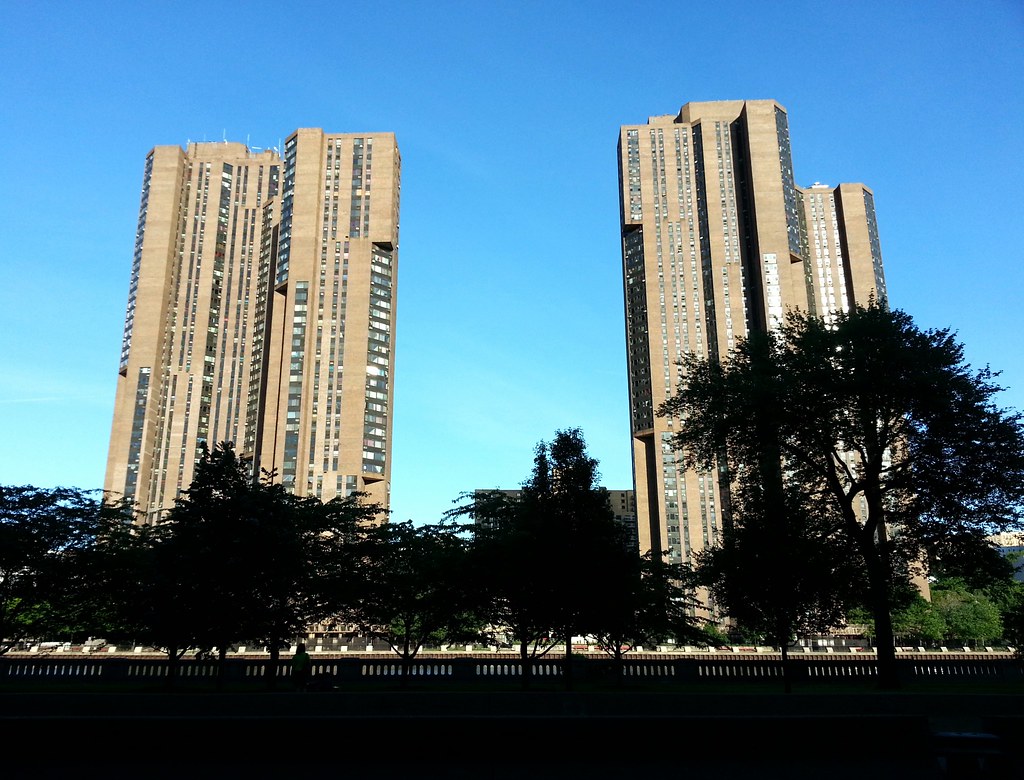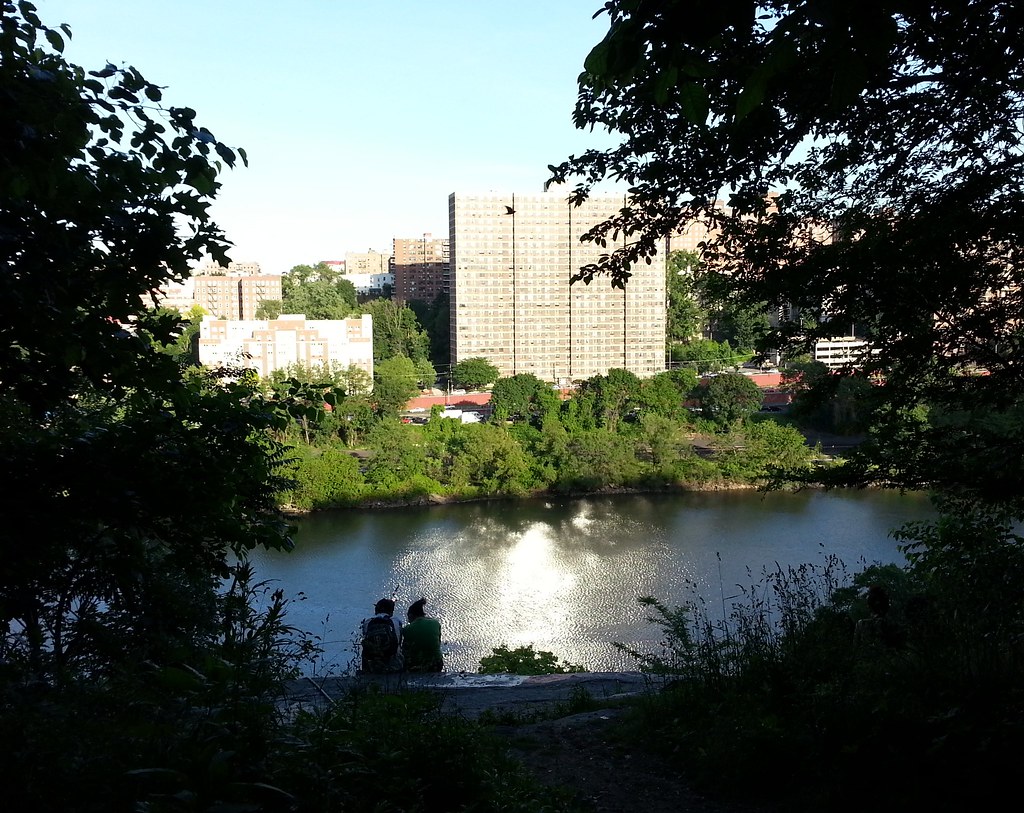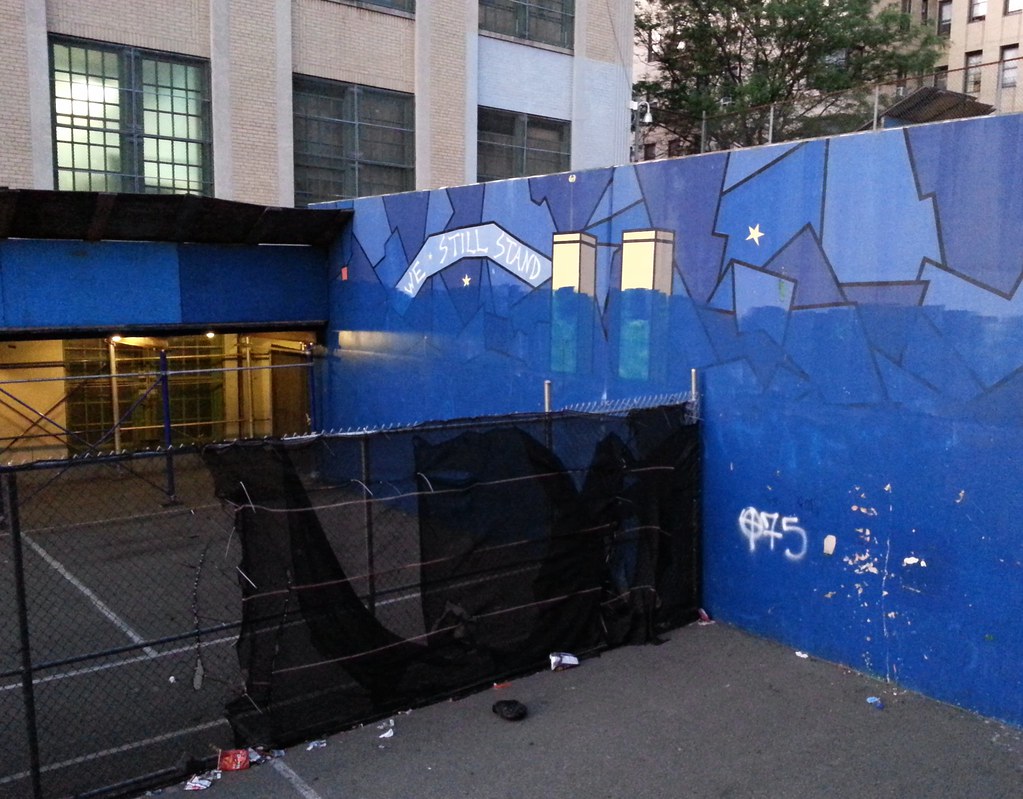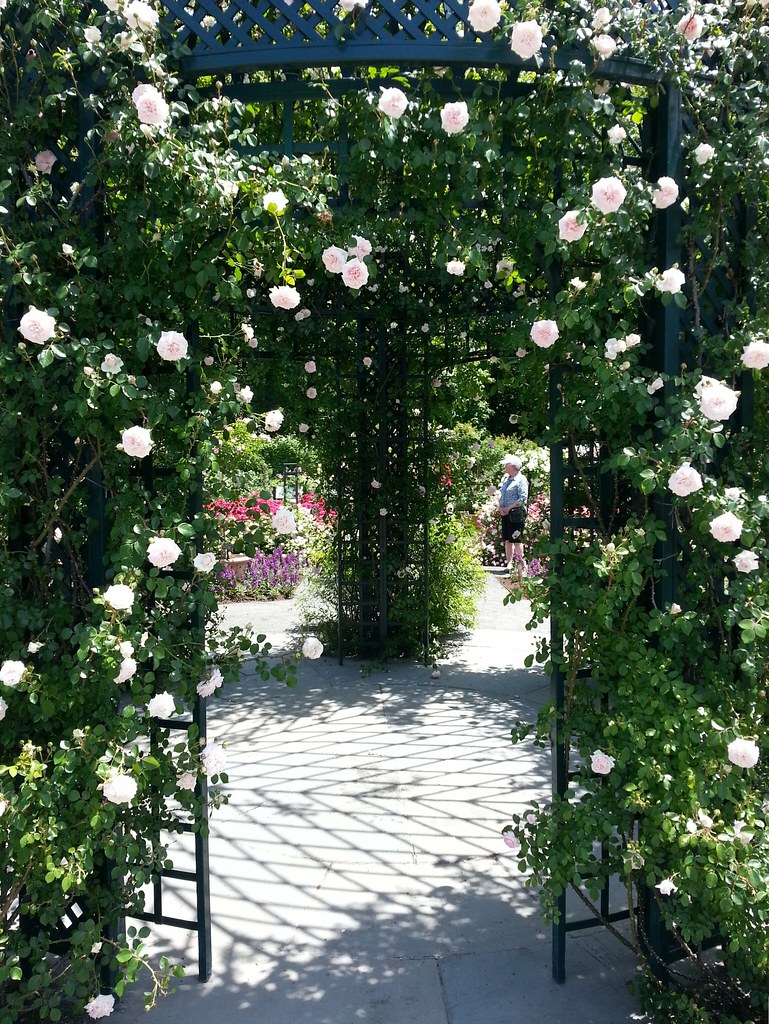
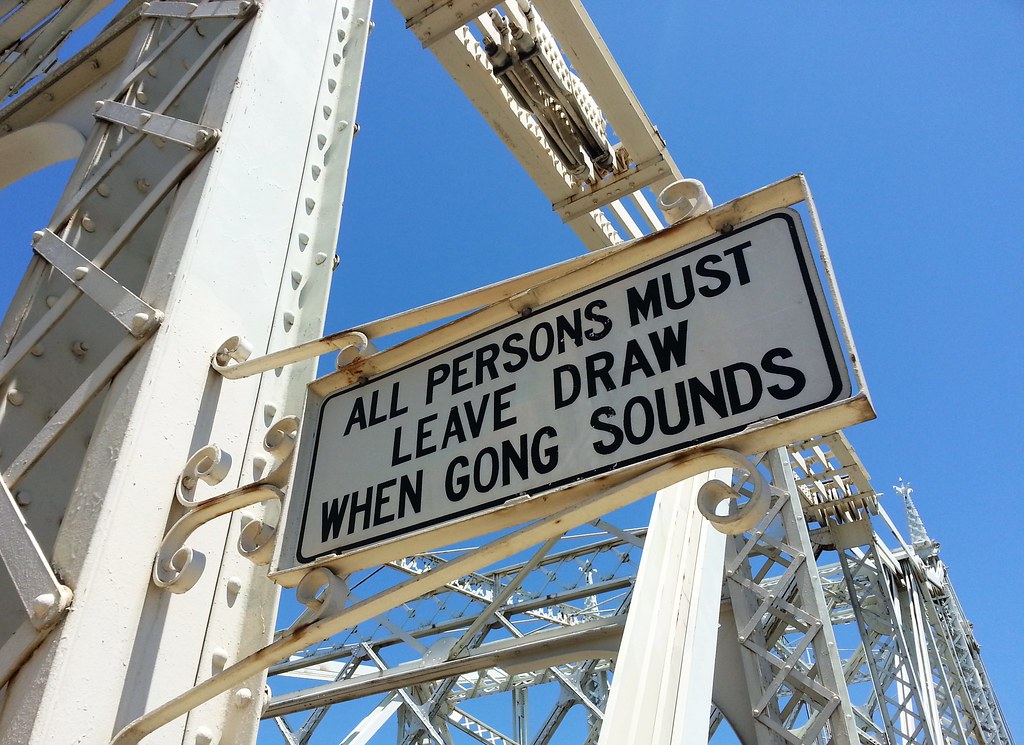
A predecessor of this bridge plays the role of antagonist in one of my favorite stories that I've learned on this walk.
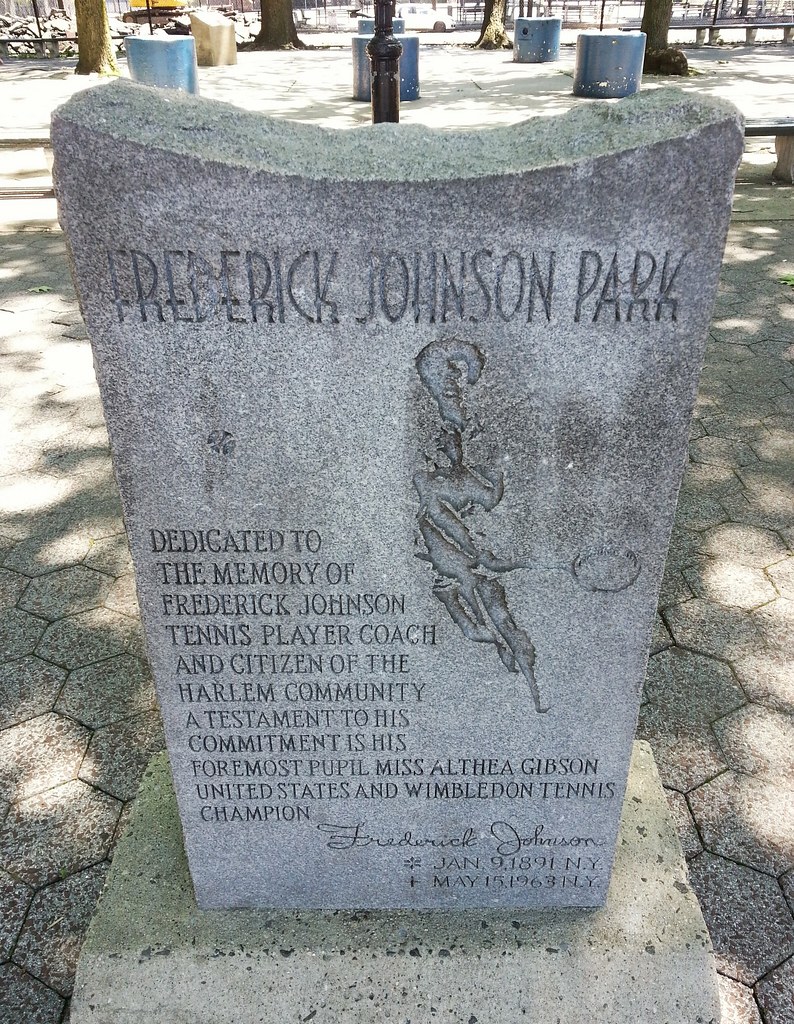
Fred was a one-armed tennis coach who gave Althea Gibson her first lesson.
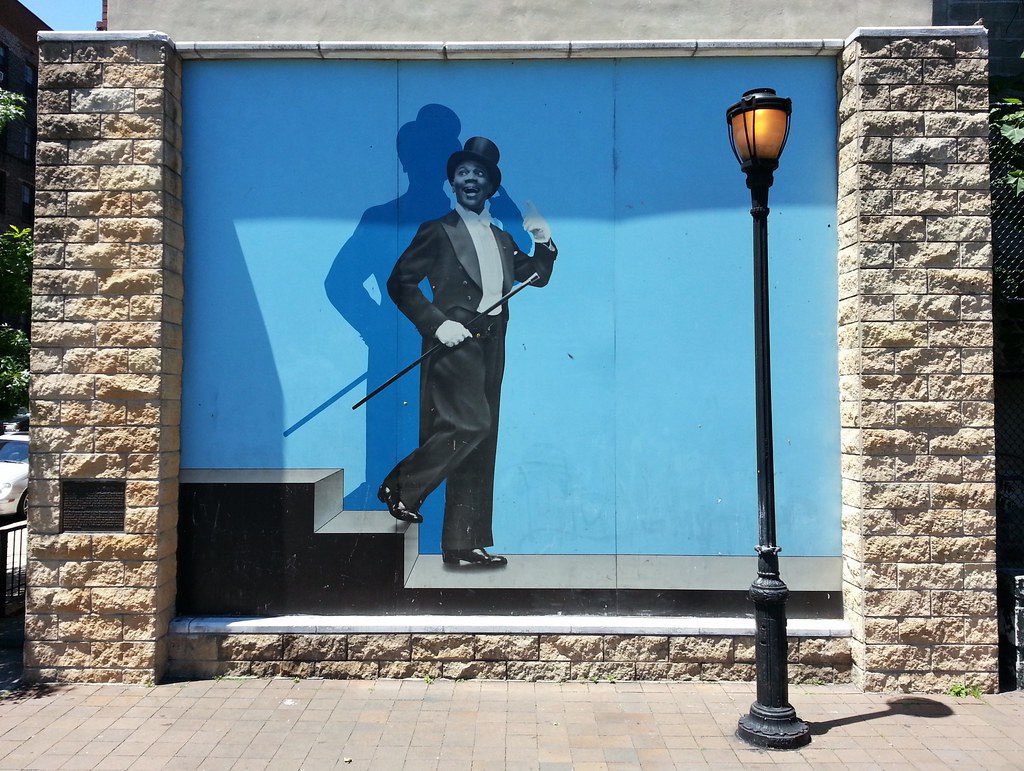
In 1934, this tap-dancing "mayor of Harlem", who lived across the street in the Dunbar Apartments (and now, as we've seen, resides in the Evergreens Cemetery), convinced John D. Rockefeller Jr. to deed this land to the city as a public park. The mural above, complete with "a shadow cast by an actual period street lamp of the type that existed in Harlem during Robinson’s heyday", shows Bojangles performing his famous "stair dance".

Like the trough we saw outside the ASPCA's old headquarters in Brooklyn, this fountain dates back to the days when thirsty horses filled the streets of New York City. It was built in 1894 with funds willed by the "civic-minded businessman" John Hooper for the construction of two fountains, one each in the then-separate cities of New York and Brooklyn, "whereat man and beast can drink" (note the different basins for horses, dogs, and people).
The Brooklyn fountain was dismantled long ago, as "horse and sturdy ox . . . vanished in a cloud of gasoline exhalations”, but this one held strong, "stand[ing] there in the traffic with the serene inconsequence of a megatherium on Broadway." It was removed and put in storage for two decades after being partially destroyed by an act of column-toppling vandalism in the early 1980s, but it persevered and was eventually restored and reconstructed. There's now a standard water fountain head for the humans, while the horse and dog basins appear to be inoperative. (A couple of lucky equines did get to lap water from the fountain at its 2001 ribbon-cutting ceremony*, however.)
* If you read the linked article, you'll notice a profusion of nicknames in use — classic Henry (StarQuest) Stern.
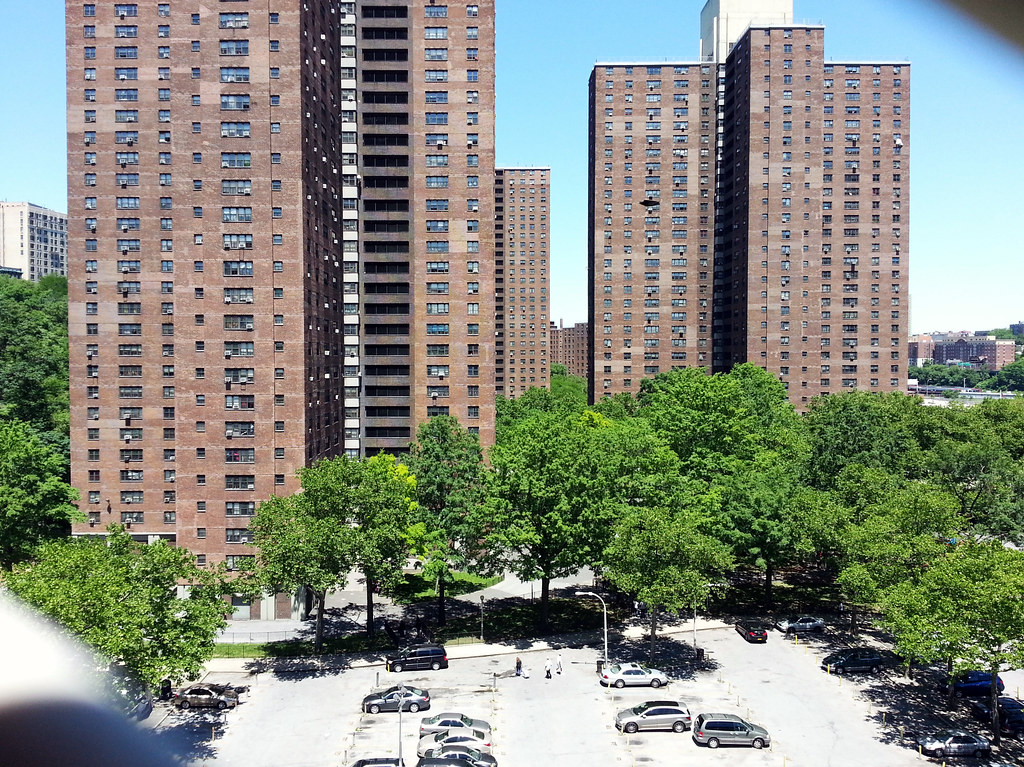
This public housing development, completed in 1968, stands on the former site of the Polo Grounds, the stadium most famously known as the home of the New York Giants baseball team. It was here that Willie Mays made The Catch and Bobby Thomson hit the Shot Heard 'Round the World and Bonehead Merkle never touched second. The Giants left New York for San Francisco after the 1957 season, and the Polo Grounds was demolished in 1964 with the same wrecking ball, painted to resemble a baseball, that had been used four years earlier to knock down Ebbets Field (which was also replaced with apartment towers).
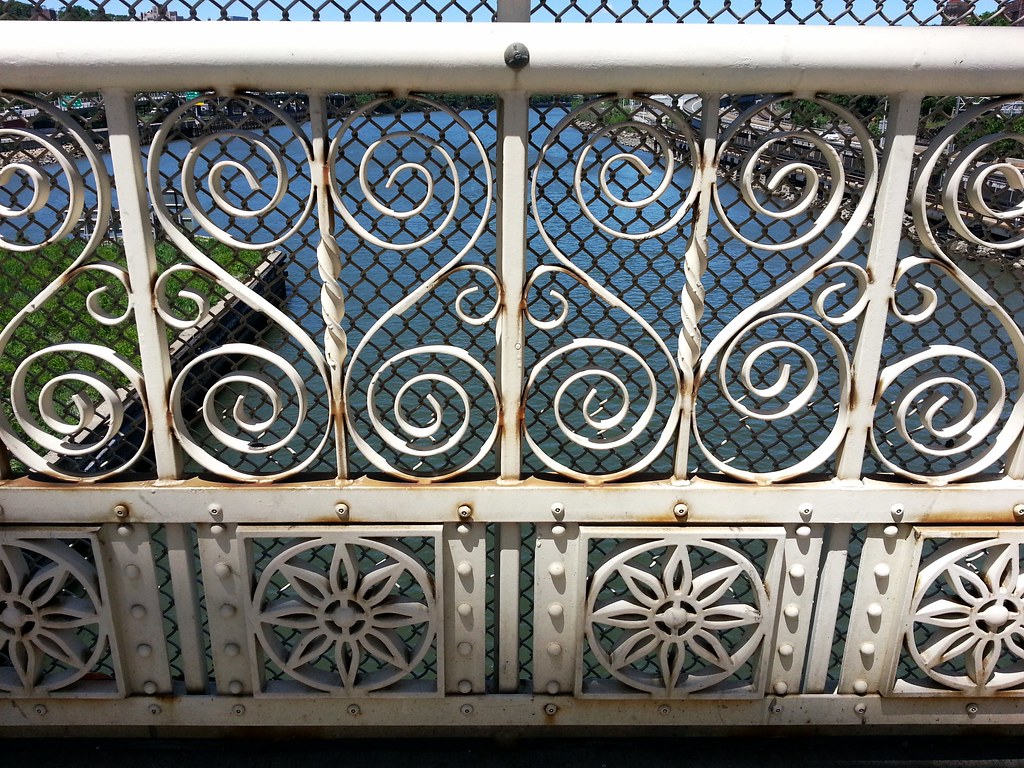
over the 1895 Macombs Dam Bridge. This railing was made by Brooklyn's Hecla Iron Works.
No feature of the original Yankee Stadium defined its architectural look more than the gently curving frieze that crowned the upper deck. The elegant topping of the three-tiered House That Ruth Built oxidized early in its life, but the green patina only made it more memorable.Having just crossed the Macombs Dam Bridge over the Harlem River from the former site of the Polo Grounds in Manhattan, I find myself wandering around Heritage Field in the Bronx, a new public ballpark built where the old Yankee Stadium once stood (that's the new stadium visible in the background), looking at a preserved section of the mid-'70s-era concrete replacement frieze, one of many features incorporated into the design of Heritage Field that offer reminders of the baseball legends who once played here.
The frieze cast an unusual shadow on the field in late afternoons and became a part of history when Mickey Mantle hit a home run to right field in 1963 that nearly hit the top of it.
Someone — the architects at Osborn Engineering in Cleveland or the Yankees' visionary owners, Jacob Ruppert and Tillinghast L. Huston — intuitively understood magnificence.
"The shape of it came from out of nowhere," said John Pastier, an architectural critic and expert on stadiums. "It was quite original. It’s not like they copied a classical design."
Philip Lowry, the author of "Green Cathedrals," a well-regarded survey of baseball stadiums, said via e-mail, "Just as shiny bumpers are the jewelry of a car, the third-deck frieze was the ornamental jewelry of Yankee Stadium." He called it unique among stadiums and ballparks that generally "followed a functional rather than an ornamental design."
The frieze lasted 50 years, until it was stripped away during the [stadium's] 1974-75 renovation and replaced by an ersatz version beyond the outfield fence and above the bleachers.
"That was a horrible architectural mistake," Lowry wrote.
Turning again to the NY Times:
When the new Yankee Stadium opened in 2009, not even the loudest of Yankee fanatics could drown out the outraged howls over its costly tickets, its tax-exempt financing and, of course, its construction atop two city parks.
But now, in an unabashed bid for redemption, New York City officials have spared no expense to deliver on a long-promised, $50.8 million public ballpark across the street from the stadium to make amends for their part in a bitter struggle over lost parkland that pitted Bronx residents against their most famous neighbor.
Heritage Field opened this week [in April of 2012], more than a year behind schedule, on the site of the old Yankee Stadium — the last of which was demolished in 2010 — and nearly every inch, from the pavement stones underfoot to the three natural grass ball fields, has been elaborately designed to pay homage to the Yankees and their celebrated former home. Even the sod is the same that the Yankees, professional baseball’s biggest spender, chose for their new stadium.
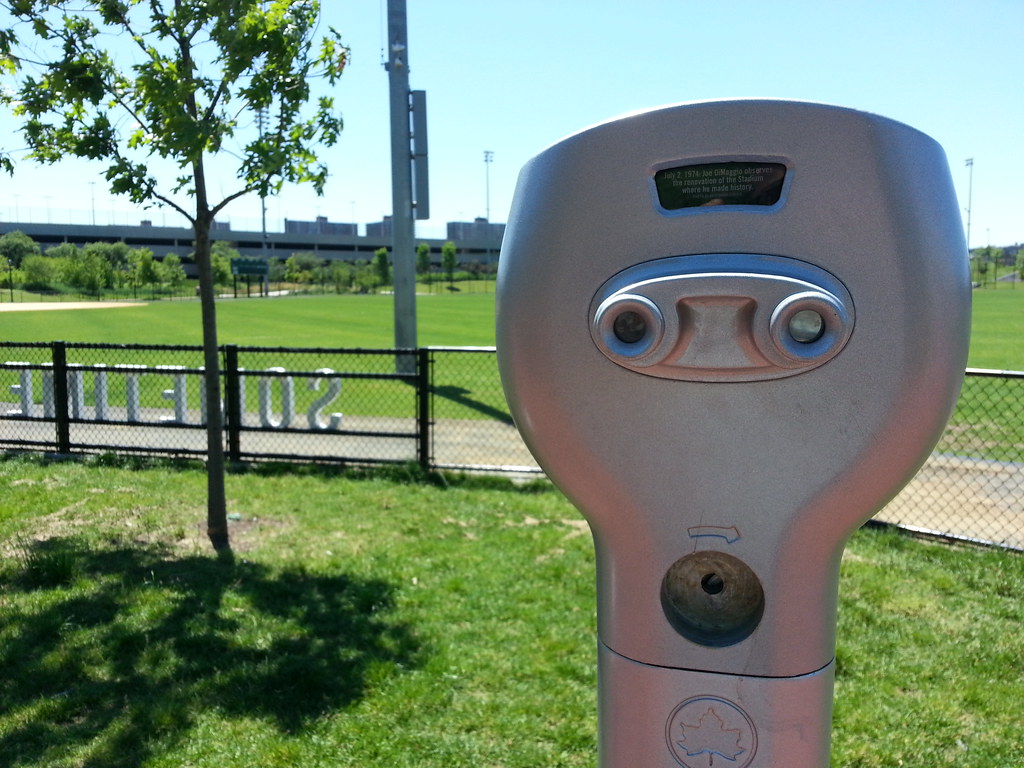
There are a number of these pole-mounted, View-Master-like stereoscopic slide viewers stationed around Heritage Field, each offering several binocular glimpses of notable moments in the history of Yankee Stadium. (The slide-turning wheel is missing on this one.) The next two photos were taken peering into these devices.

Manager Billy Martin expresses his displeasure with the home plate umpire.
Here we see the Yankees' fiery manager performing his patented dirt-kicking routine.
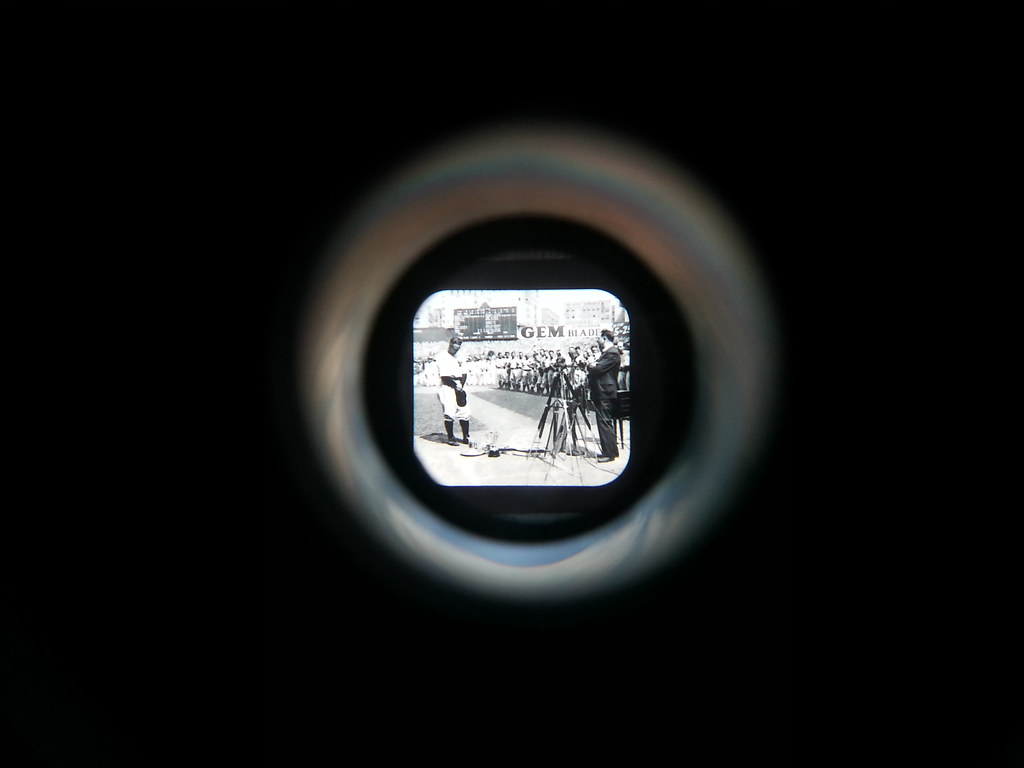
On Lou Gehrig Appreciation Day, the Yankee icon gives his "Luckiest Man" speech.
From our visit to Lou's final residence in Fieldston:
This is the house where the humble and beloved Lou Gehrig died in 1941 at the age of 37. The Yankees' legendary first baseman was a man of prodigious talent, one of the greatest hitters the game has ever seen. He became a regular in the Yankees' lineup in 1925, two years into his career, and never took a day off from that point forward. Playing through injury and illness, he had appeared in 2,130 consecutive games when he took his final swing, an unheard-of accomplishment that stood as a record for 56 years.
His unmatched toughness and reliability earned him the nickname "The Iron Horse", but even he was no match for the disease that now bears his name, which began ravaging his body in the prime of his life and knocked him out of baseball less than a year after he first began to notice its effects. Despite his extraordinary athletic achievements, Lou is best remembered for his moving retirement speech, telling the teary-eyed crowd packed into Yankee Stadium: "Fans, for the past two weeks you have been reading about the bad break I got. Yet today I consider myself the luckiest man on the face of the earth."
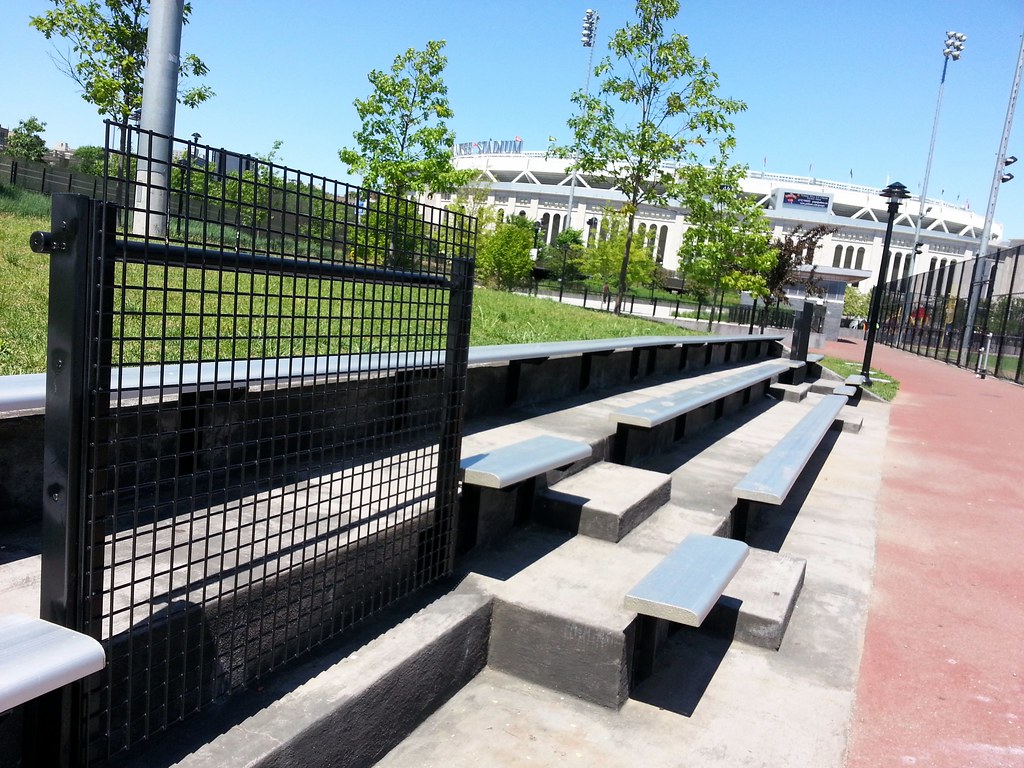
Initially, I thought these might be seats salvaged from the old Yankee Stadium bleachers, the former home of the Bleacher Creatures, but, after poking around on the web for a bit, I can see that they're not. My search wasn't entirely in vain, however, as it led me to this 1956 poem by a young John Updike:
Tao in the Yankee Stadium Bleachers
Distance brings proportion. From here
the populated tiers
as much as players seem part of the show:
a constructed stage beast, three folds of Dante’s rose,
or a Chinese military hat
cunningly chased with bodies.
“Falling from his chariot, a drunk man is unhurt
because his soul is intact. Not knowing his fall,
he is unastonished, he is invulnerable.”
So, too, the “pure man”—“pure”
in the sense of undisturbed water.
“It is not necessary to seek out
a wasteland, swamp, or thicket.”
The opposing pitcher’s pertinent hesitations,
the sky, this meadow, Mantle’s thick baked neck,
the old men who in the changing rosters see
a personal mutability,
green slats, wet stone are all to me
as when an emperor commands
a performance with a gesture of his eyes.
“No king on his throne has the joy of the dead,”
the skull told Chuang-tzu.
The thought of death is peppermint to you
when games begin with patriotic song
and a democratic sun beats broadly down.
The Inner Journey seems unjudgeably long
when small boys purchase cups of ice
and, distant as a paradise,
experts, passionate and deft,
hold motionless while Berra flies to left.
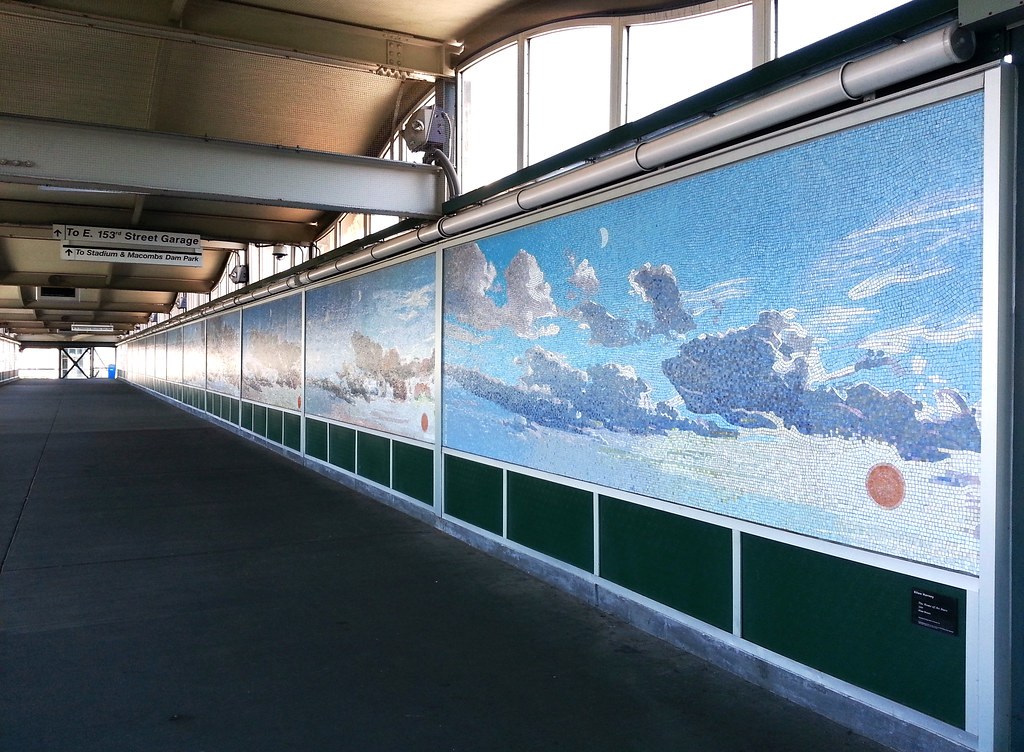
"I thought it would be nice to take the stars and de-brand them in a way."
This piece by Ellen Harvey (more photos and info here) lines a passageway at the Yankee Stadium Metro-North station. According to the artist:
The mosaic consists of eleven 18 ft. by 6.75 ft. panels. The panels show a sunset and moon and star rise in 15 minute increments, starting at 6.30pm (the time most Yankee fans would be arriving at the train station for an evening game) and ending at 9 pm. The sky depicted is based on watercolors based on photographs of a typically spectacular Bronx sunset and the location of the sun, moon and stars are those that viewers would experience gazing in the direction of the walkway wall in April of 2009 (the completion date of the new Yankee Stadium). Of course, given the light pollution of the city, the stars in the final panels of the mosaic would never actually be visible to the naked eye.

This was merely an exhaust stack for the old Yankee Stadium until Joe Garagiola Jr. reportedly had the idea to ask Hillerich & Bradsby, the company that makes Louisville Sluggers, to stick a knob-like protrusion on the top and turn it into a gigantic Babe Ruth-model bat. Predating the peeling tape on the handle, supersized versions of the batmaker's logo and the Babe's signature once adorned the shaft, but seem to have been lost to subsequent paint jobs. The Bat became a popular meeting place for fans outside the old stadium, and, while the stadium has since been torn down, The Bat remains, now towering above Heritage Field and the passageway to the new Metro-North station.
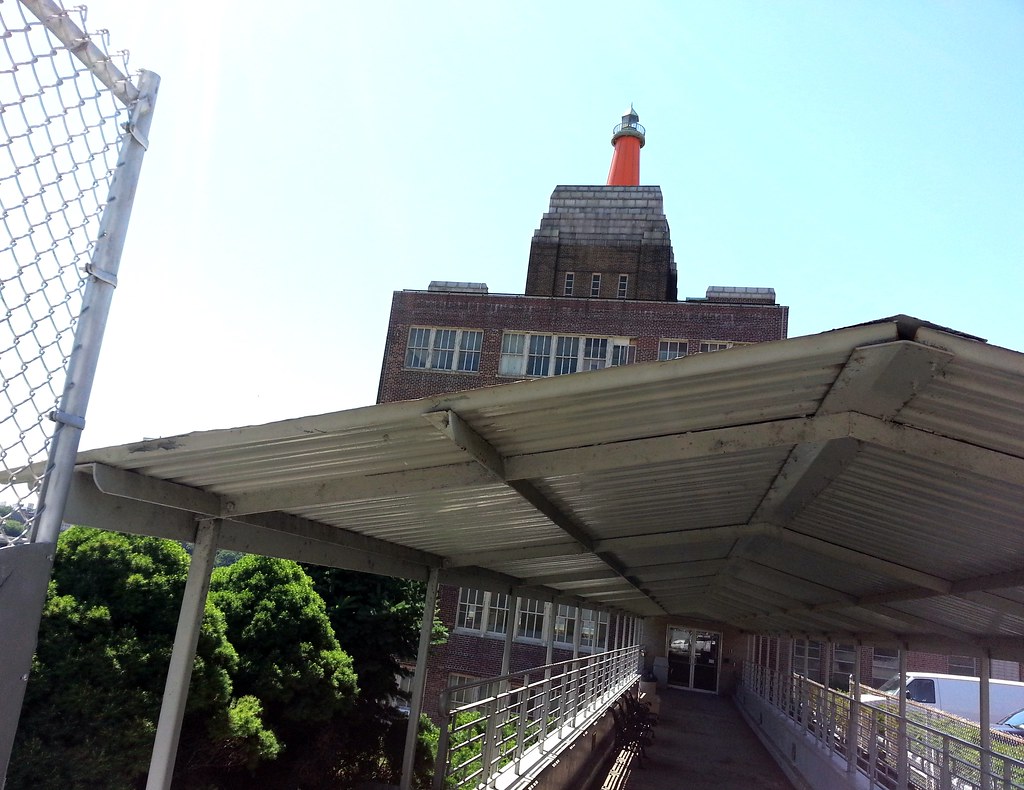
The Harlem River lighthouse is now orange! It was repainted by a self-storage firm that has taken over the property since our last visit.
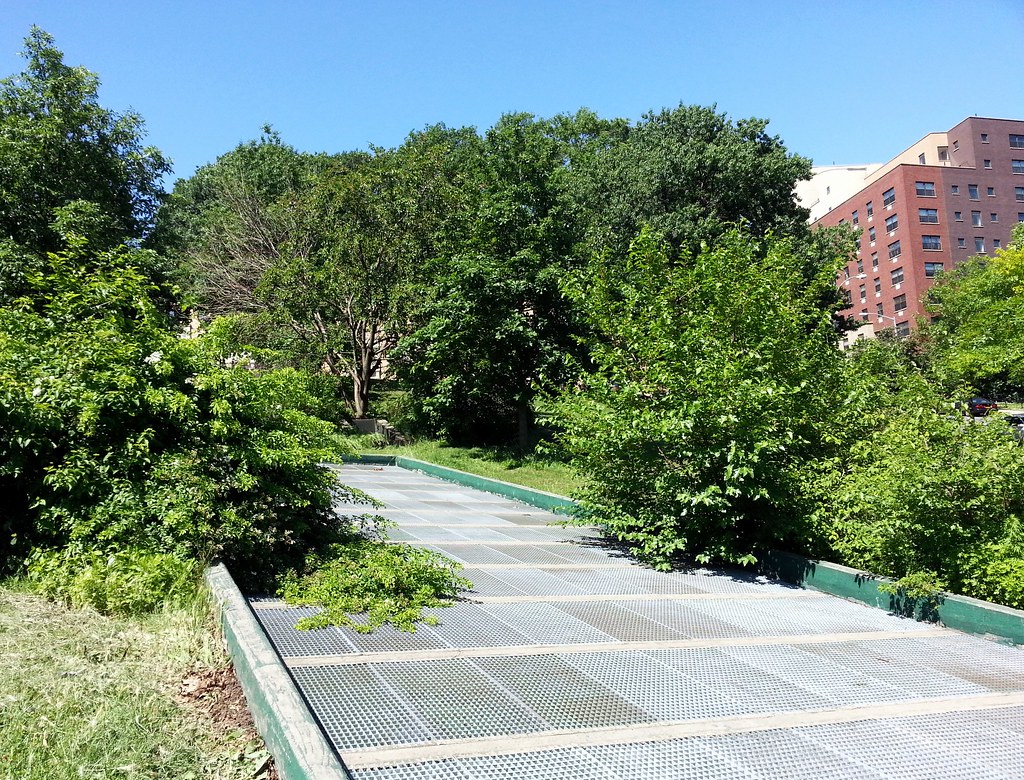
This hillside array of grates, located near the Bronx end of the Concourse Tunnel (which carries the B and D trains beneath the Harlem River), is presumably used for subway ventilation.
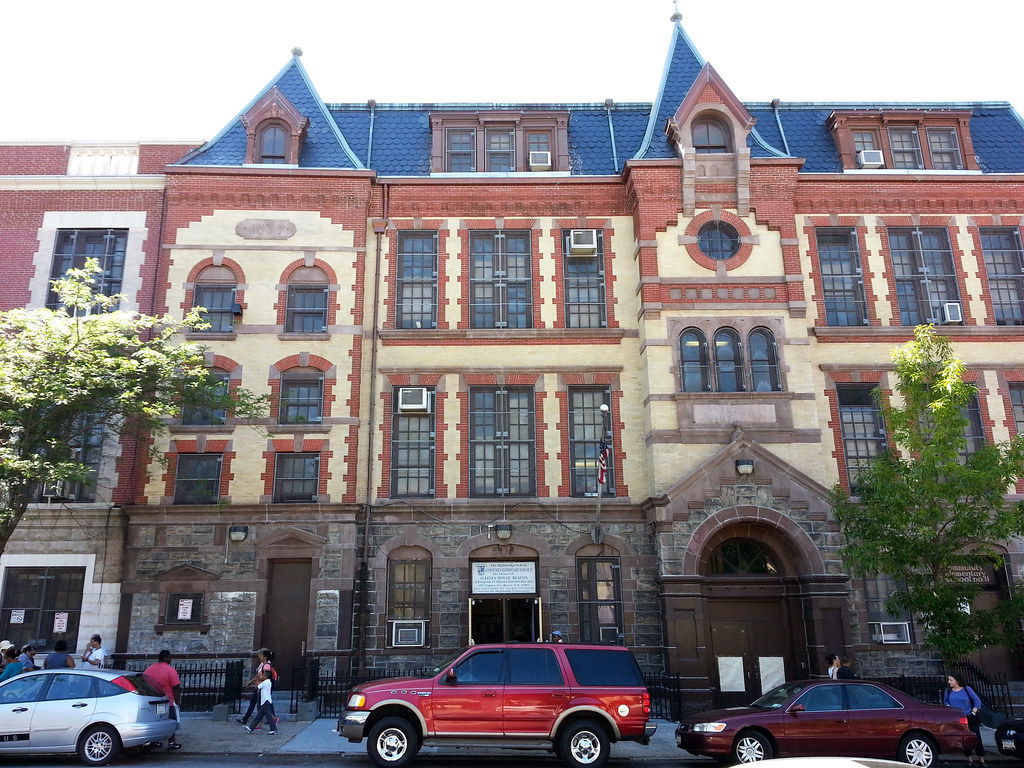
The former Grammar School No. 91, "one of the finest examples of the [Romanesque Revival] style in the Bronx", was built in 1889 "of brick and Harlem River stone". It was designed by George W. Debevoise, the predecessor of Charles B.J. Snyder.
In 1895, when the school was "known for its cleanliness, the entire building being especially inviting", a delegation of visiting school officers was "entertained at assembly by singing from the school, solos from two young lady pupils, and an attractive drill with umbrellas and dumb bells. The visitors expressed their gratification with the discipline of the school and the uniformly neat and refined appearance of the children."
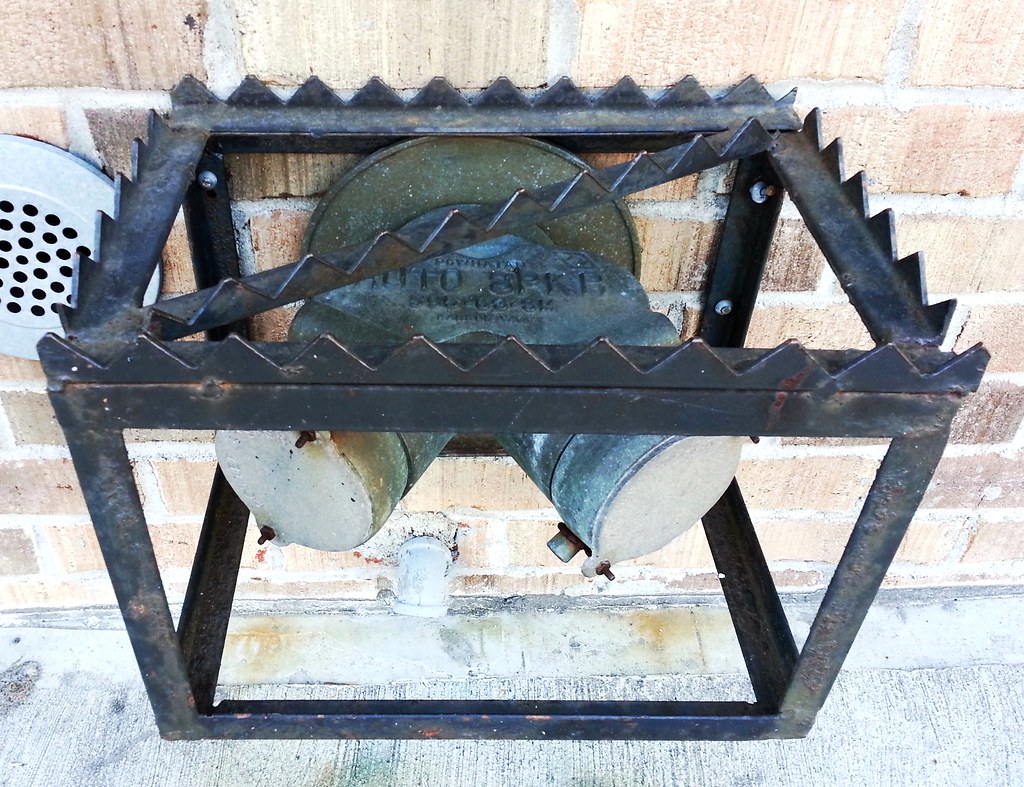
Meanwhile, on the other end of the spectrum...
Or is this the other end of the spectrum? More precise spectrum definition needed!

On several occasions, I've seen vehicles pull up to open fire hydrants and drive really slowly through the spray. It seems like this would only get about one-third of your car clean-ish (and you can't turn around to wash the other side on these one-way streets), but, hey, who doesn't love free stuff?

To walk all around the neighborhood of Highbridge is to walk up and down ten million stairs. Ahead: one of many precipitous drops I would encounter on my route today.
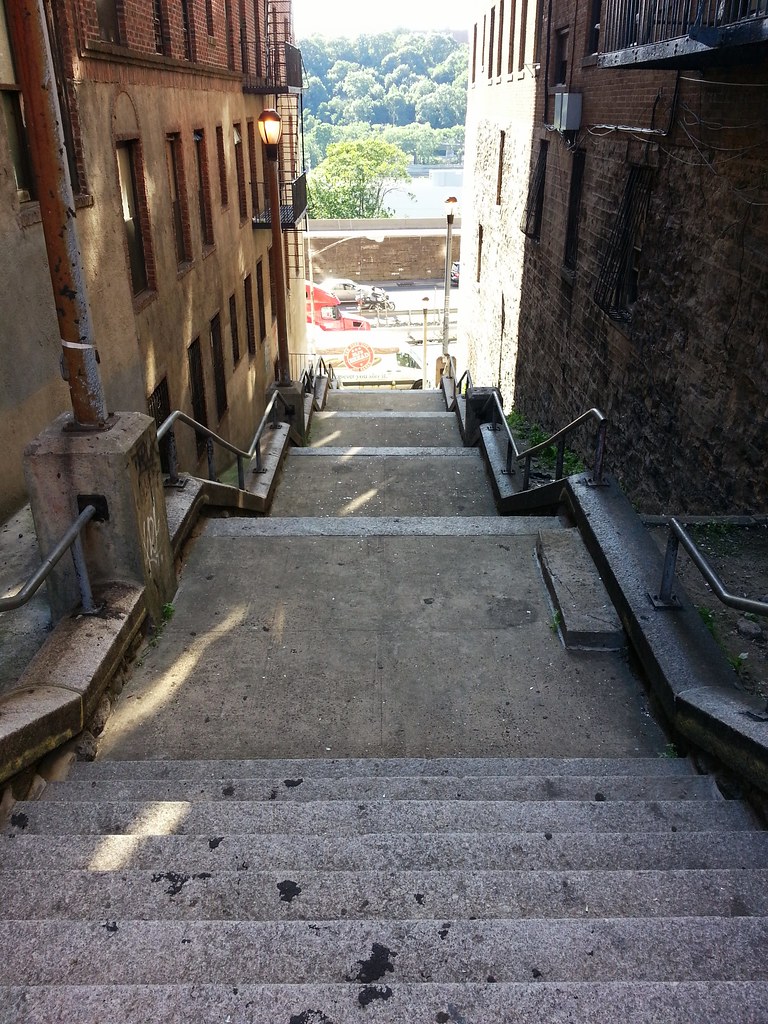
Those are the treed slopes of Manhattan's Highbridge Park across the Harlem River.
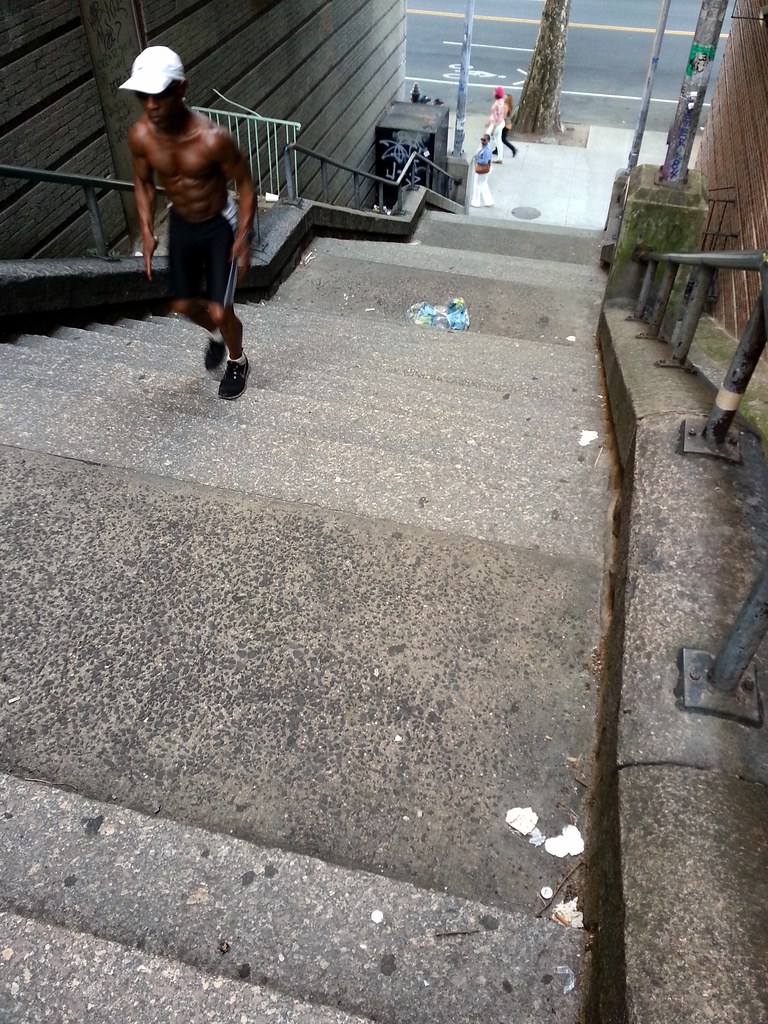
There's a sizable subset of males in certain parts of this city who find no shame in, and who make a regular practice of, stopping dead in their tracks, pivoting around, and blatantly ogling the backsides of attractive women who pass them on the sidewalk. (I'm sure they're ogling the frontsides as well, but the focus of their gaze only becomes apparent to an observer once they perform the conspicuous 180-degree spin move.) Their expressions and body language often exude an aggressive, amped-up machismo, which has always led me to assume that they probably also exhibit other behaviors common among the tough-guy crowd — namely, for the purposes of this story, homophobia. Or, to be more precise, a fear of undermining the facade of virile, heterosexual masculinity that they are trying to present to the world.
The gentleman you see before you, getting in his cardio workout for the day by running up and down this interminable staircase, is an extraordinary physical specimen. His abs look like they could be put into service as a commercial grapefruit juicer. To no great surprise, his almost comically well-toned torso grabbed the attention of several female passersby, including the middle-aged woman at the bottom of the staircase drinking in the scene as she snails her way down the block. (Just moments before, the girl in the pink hat was catching a healthy eyeful as well.)
Shattering the stereotypes I had constructed, however, were the half-dozen men I saw whose swagger and gait were typical of the aforementioned fanny oglers, but who didn't hesitate for a second to give this guy the exact same kind of totally obvious stop-what-you're-doing-and-drop-your-jaw treatment that they normally reserve for the well-proportioned lady-strangers in their lives. Any worry of "looking gay" in front of their friends was relegated to the nether corners of their minds, if even present at all. They were just basking, happily and publicly, in the glorious abdominal aura of a shirtless Adonis whose path they were fortunate enough to cross on a sunny June afternoon.
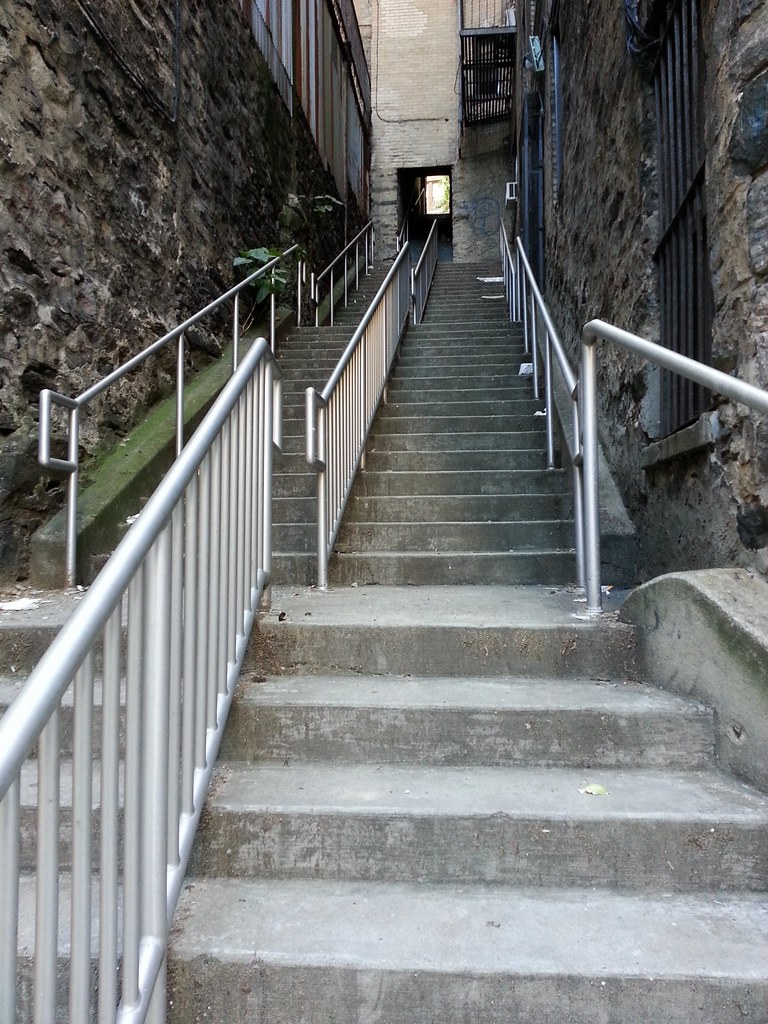
Passing through a darkened corridor beneath an apartment building
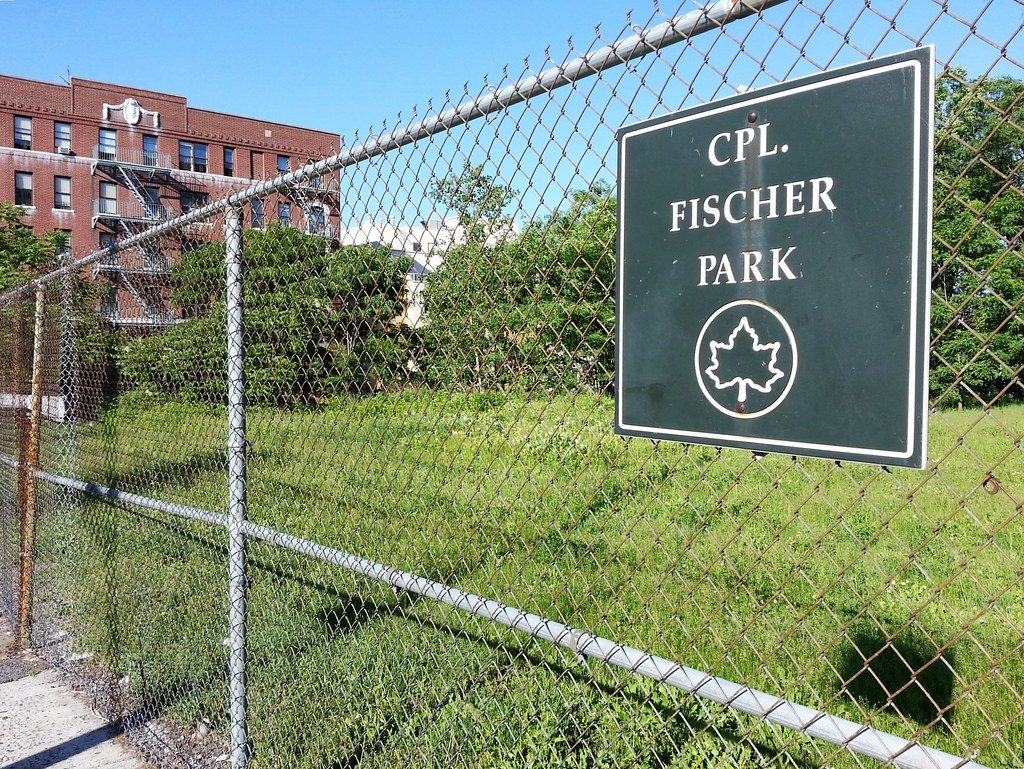
An unkempt, fenced-off, half-acre lot. I understand that the city can't afford to maintain every piece of property it owns, but it seems like the Parks Department is just teasing the community by putting up a sign that calls this inaccessible green space a park.
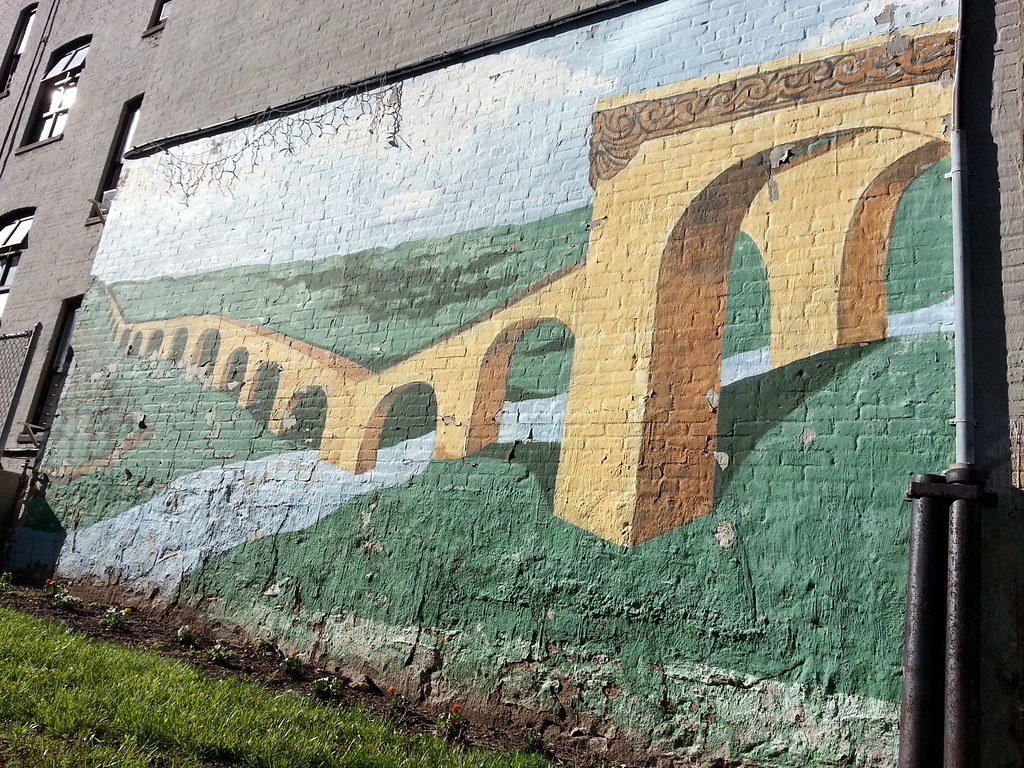
Despite the water-carrying impracticality of the up-and-down slopes atop its arches, this painted structure bears more than a passing resemblance to the original appearance of the Roman-inspired, aqueduct-carrying river crossing that gave the neighborhood of Highbridge its name.
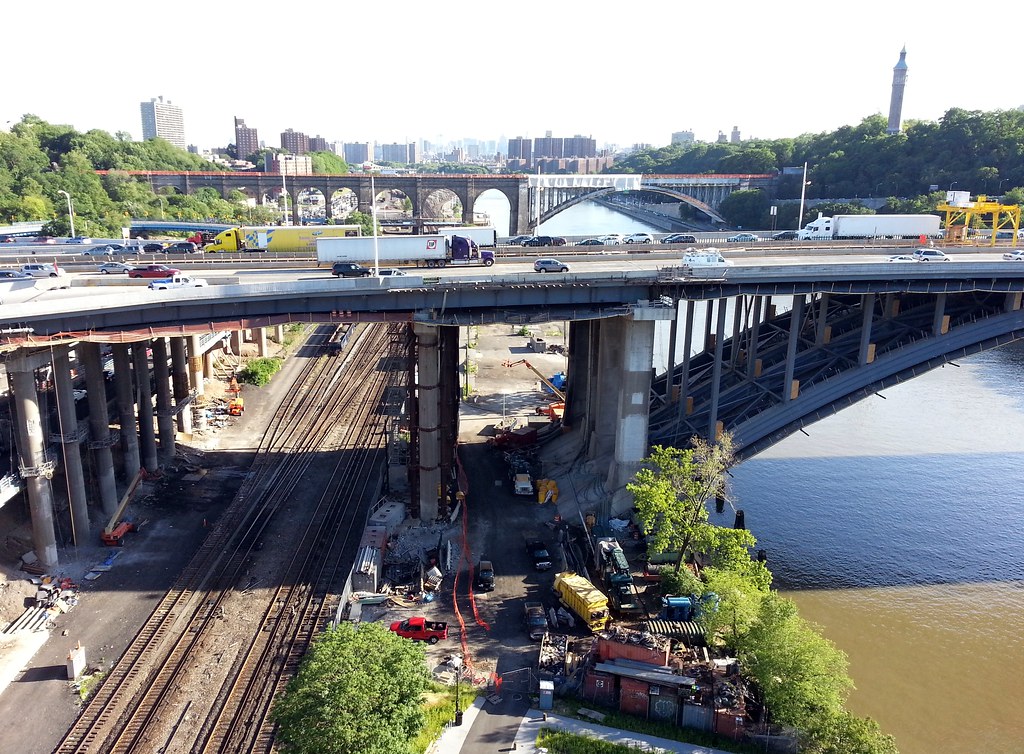
Heading toward Manhattan over the Washington Bridge, we can see the rails of Metro-North's Hudson Line; the southern tip of a new, yet-to-be-opened park beside the Harlem River; the Hamilton Bridge in the foreground; and, in the back, the High Bridge, which is currently being rehabilitated and is supposed to reopen to pedestrians and bikers (it's always been car-free) sometime next year after being closed for more than four decades.
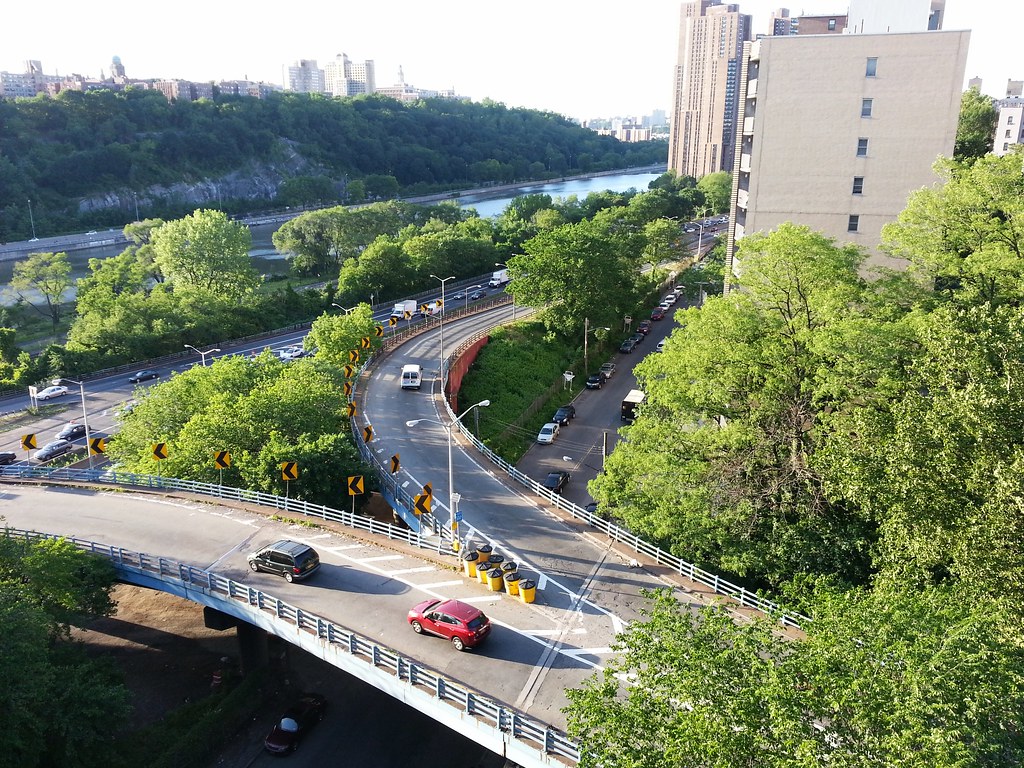
I'm back in the Bronx after a loop around Manhattan's Highbridge Park, visible across the Harlem River.

Two of the Bronx's great street names: Featherbed Lane and Shakespeare Avenue
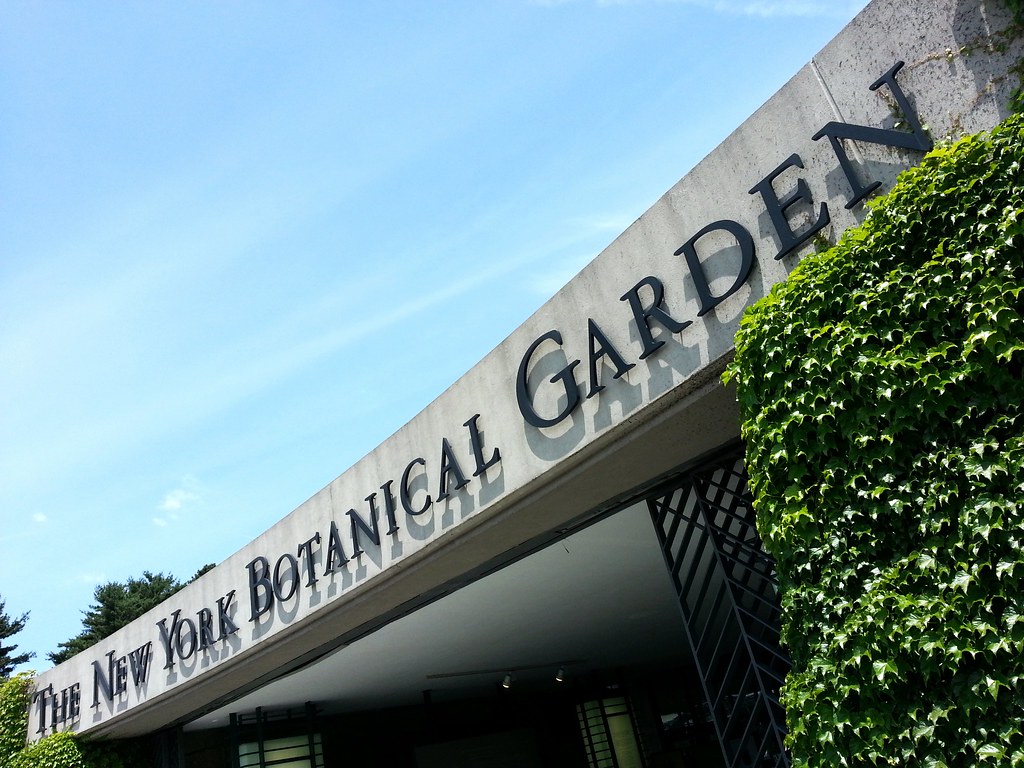
I knew from the outset of this project that I would do lots of non-street walking in parks and cemeteries around the city. Those spaces are like streets in an important way, in that they're freely open to the wandering public, at least during certain hours. I wasn't planning to include places like the New York Botanical Garden, which charge admission, effectively walling them off from what I consider the public landscape of the city. (I don't have anything against paying money to support such places; they just lie outside the scope of my walk.) However, when I discovered that (most of) the garden is admission-free on Wednesdays, I realized that I needed to include it as well.
(Perhaps you recall my brief foray into the garden on a late Sunday afternoon last December, before I had decided to incorporate the place into my walk. Normally the boundaries between public streets and big-places-you-have-to-pay-to-get-into are fairly apparent, demarcated by gates and admission booths and the like. Approaching the garden, I expected to reach a nice, obvious barrier telling me not to go any farther, at which point I would turn around and continue on my way. But things are not so clear-cut here. I ended up on a peripheral road inside the property [leading to the gorgeous Lillian Goldman Fountain of Life] without any idea of whether I was allowed to be there without a ticket. It was too late in the day to try to work a bunch of unexpected miles into my route, so I decided to come back another time to figure out which parts I needed to walk.)
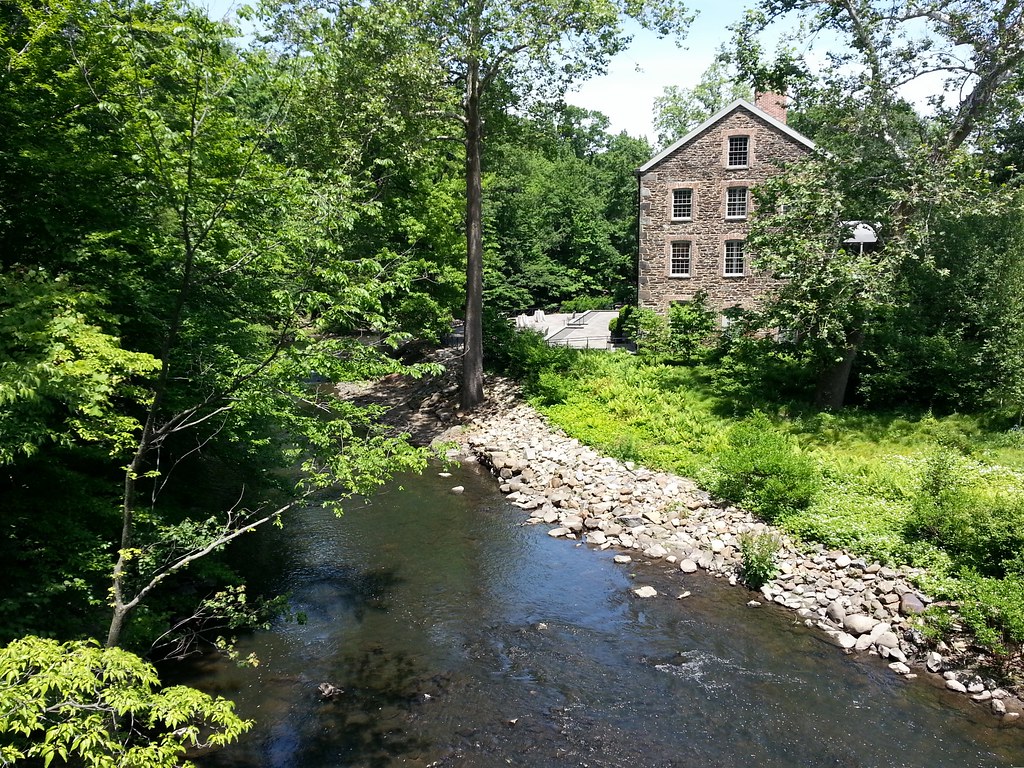
"The nation's oldest extant tobacco factory", this mill once harnessed the power of the Bronx River to grind tobacco leaves into snuff. It was built in 1840 by the Lorillard family, founders of the Lorillard Tobacco Company, which makes Newport and Kent cigarettes, among others.
Now standing on the grounds of the New York Botanical Garden, and used, in part, as an event space, the mill was rechristened the "Lillian and Amy Goldman Stone Mill" in 2010. The Goldman family was a major donor to the building's recent restoration, so I understand that part of the new name. But why did they change "Snuff Mill" to "Stone Mill"? Was it some kind of rebranding effort intended to obscure the building's undesirable tobacco-related past? (The garden's website says nothing about tobacco in its brief historical description of the structure.) Were they worried people wouldn't want to hold lucrative social events at a place with "Snuff" in the name? Or did the Goldman family just not want to be associated with tobacco?
Whatever the case, I don't like it! The caretakers of our city's historical heritage shouldn't be selectively concealing the parts of that heritage that they find distasteful or unprofitable. If the garden's board just wanted to change the building's name, that would be one thing, but I couldn't even find a mention of the mill's original use on any of the nearby informational signs, which instead told me that the building is "an irreplaceable piece of American history" and "one of New York City's most picturesque structures". The only exceptions to this historical whitewashing were a couple of old maps, still bearing the name "Snuff Mill", that were posted here and there as navigational aids. (I saw one poor fellow staring at one of these maps in absolute befuddlement, because the directions he had been given were in relation to a "Stone Mill", but he could only find a "Snuff Mill" on the map.)

Somewhere in the vicinity of the Rose Garden, which features over 600 varieties of roses, is the former site of the Lorillard family's "Acre of Roses", whose petals they used to scent the snuff that they ground in their mill.
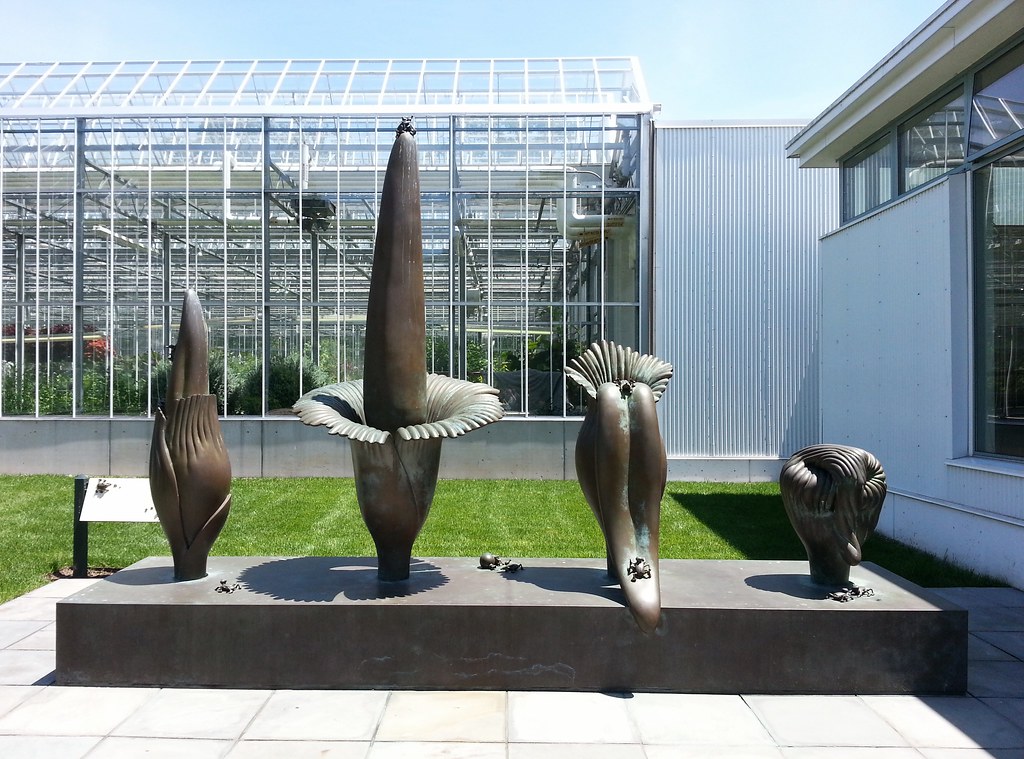
This sculpture by Tom Otterness celebrates the "giant shapeless phallus" (to translate from the Latin), or corpse flower, as it is more commonly known. This monstrous plant, which goes years between blooms (you can see photos of one blooming here), and which smells like a decomposing carcass when it does bloom, produces an inflorescence ("the largest unbranched inflorescence in the world") that can exceed 10 feet in height. Its corm, an underground organ that stores the plant's energy until it's ready to bloom again, is the largest such structure known to exist, tipping the scales, in some cases, at 200 pounds or more.
The corpse flower is native to the Indonesian island of Sumatra, but its first documented bloom in the Americas took place right here at the New York Botanical Garden in 1937. When a second one bloomed here in 1939, the Bronx borough president at the time, James J. Lyons (the same guy who planted a flag in Marble Hill and claimed it as the Bronx Sudetenland), was so impressed by the plant that he decided, on the spot, to name it the borough's official flower, a title it held until 2000, when the day lily stole its throne. (For those curious, the most recent corpse flower bloom in the city, as far as I can tell, occurred in 2006 at the Brooklyn Botanic Garden.)

Another mid-19th-century relic of the Lorillard estate. I don't know if the cottage still serves as a residence, but in 1992 it was home to one of the Botanical Garden's managers and his family, and, before that, one of the garden's vice presidents.

